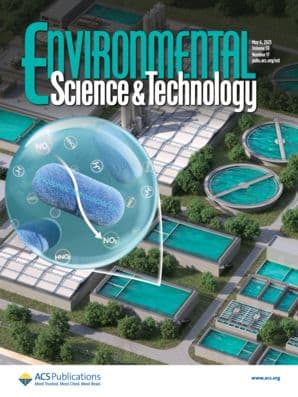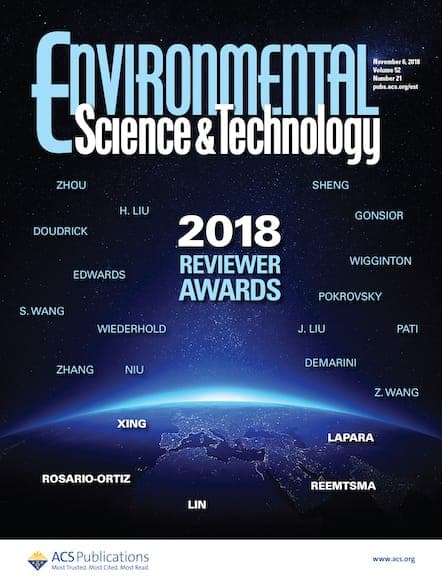Beer is more than 90% water—so what happens when that water is contaminated? A recent study traces “forever chemicals” from tap water into the beers brewed with it, raising new concerns for brewers and consumers alike.

Beer has been a popular drink for millennia, deemed safer than water in the past due to the destruction of pathogens during the brewing process. But today, our water supplies are contaminated with more than just pathogens. In response to public health fears, the World Health Organization has begun developing guidelines for per- and polyfluoroalkyl substances (PFAS) in drinking water.1 PFAS are a group of manmade chemicals2 used across a huge range of industries, from nonstick cookware to firefighting foams. They also contain one of the strongest known carbon–fluorine bonds, making them highly resistant to breakdown in the environment and earning the name "forever chemicals."
PFAS have been found in both bottled and tap water.3 It's been estimated that up to 80 million people in the United States receive tap water with at least 10 ng/L concentrations of perfluorooctanoic acid and perfluorooctanesulfonate4—more than double the EPA's Maximum Contaminant Levels (MCLs).5
A research team in North Carolina recently set out to investigate whether PFAS in municipal water supplies could be traced into commercially available beers. While PFAS contamination in drinking water has been widely studied, little has been revealed about how these chemicals might end up in beer and similar beverages—but since beer is more than 90% water, it was assumed that PFAS were entering the brewing cycle in some capacity.

Hold My Beer: The Linkage between Municipal Water and Brewing Location on PFAS in Popular Beverages
DOI: 10.1021/acs.est.4c11265
The researchers conducted statistical analyses to correlate regional levels of PFAS in drinking water, analyzing beers by brewing location. Their methods revealed that:
- PFAS were detected in 95% of the beers tested.
- Smaller breweries located near known PFAS-contaminated water sources had notably higher levels.
- A county-level correlation was found between PFAS levels in drinking water and those in locally brewed beers.
Given that approximately 18% of U.S. breweries are located in areas with detectable PFAS in municipal drinking water, these findings could help inform data-driven policies on PFAS in beverages for governmental agencies, as well as provide insight for brewers and water utilities on treatment needs. “I hope these findings inspire water treatment strategies and policies that help reduce the likelihood of PFAS in future pours," noted research lead Jennifer Hoponick Redmon in a recent press release.
The authors also report that their study is the first to adapt the EPA's Method 533 to measure PFAS in beer from various regions, brewery types, and water sources.7
Explore Related Content on PFAS from ACS Publications
ACS Journal Articles
Emerging Per- and Polyfluoroalkyl Substances in Tap Water from the American Healthy Homes Survey II
Jason D. Boettger*, Nicole M. DeLuca, Michael A. Zurek-Ost, Kelsey E. Miller, Christopher Fuller, Karen D. Bradham, Peter Ashley, Warren Friedman, Eugene A. Pinzer, David C. Cox, Gary Dewalt, Kristin K. Isaacs, Elaine A. Cohen Hubal, and James P. McCord
DOI: 10.1021/acs.est.4c08037
Biotransforming the “Forever Chemicals”: Trends and Insights from Microbiological Studies on PFAS
Justin P. Skinner*, Alia Raderstorf, Bruce E. Rittmann, and Anca G. Delgado*
DOI: 10.1021/acs.est.4c04557
Target and Suspect Screening Reveal PFAS Exceeding European Union Guideline in Various Water Sources South of Lyon, France
Termeh Teymoorian, Louis Delon, Gabriel Munoz, and Sébastien Sauvé*
DOI: 10.1021/acs.estlett.4c01126
An Overview of Potential Alternatives for the Multiple Uses of Per- and Polyfluoroalkyl Substances
Romain Figuière*, Luc T. Miaz, Eleni Savvidou, and Ian T. Cousins
DOI: 10.1021/acs.est.4c09088
Exposure to Legacy Per- and Polyfluoroalkyl Substances from Diet and Drinking Water in California Adults, 2018–2020
Emily H. Pennoyer*, Toki Fillman, Wendy Heiger-Bernays, Kathleen R. Attfield, Hyoung-Gee Baek, Songmei Gao, Sabrina Smith, June-Soo Park, Nerissa Wu, and Thomas F. Webster
DOI: 10.1021/acs.est.4c11872
What Do We Know About Per- or Polyfluoroalkyl Substances (PFASs)? Issues, Challenges, Regulations, and Possible Alternatives
Bruno Ameduri*
DOI: 10.1021/acs.macromol.4c02993
Filling the Gaps in PFAS Detection: Integrating GC-MS Non-Targeted Analysis for Comprehensive Environmental Monitoring and Exposure Assessment
Seth R. Newton*, John A. Bowden, Nathaniel Charest, Stephen R. Jackson, Jeremy P. Koelmel, Hannah K. Liberatore, Ashley M. Lin, Charles N. Lowe, Sofia Nieto, Krystal J. Godri Pollitt, Anna R. Robuck, Pawel Rostkowski, Timothy G. Townsend, M. Ariel Geer Wallace, and Antony John Williams
DOI: 10.1021/acs.estlett.4c00930
Blog Posts
Understanding the Flow of PFAS Between Oceans
PFAS: Fighting Chemistry With Chemistry
Phasing Out PFAS in Consumer Products
PFAS: A Look at Alternatives and Environmental Pollution
References
- World Health Organization. PFOS and PFOA in Drinking-water: Background document for development of WHO Guidelines for Drinking-water Quality.
https://www.who.int/teams/environment-climate-change-and-health/water-sanitation-and-health/chemical-hazards-in-drinking-water/per-and-polyfluoroalkyl-substances - A guide to the PFAS found in our environment. Chemical & Engineering News. https://cen.acs.org/sections/pfas.html
- Gao, C. et al. Factors Influencing Concentrations of PFAS in Drinking Water: Implications for Human Exposure. ACS EST Water 2024, 4, 11, 4881–4892.
- Andresws, D. Q. and Naidenko, O. V. Population-Wide Exposure to Per- and Polyfluoroalkyl Substances from Drinking Water in the United States. Environ. Sci. Technol. Lett. 2020, 7, 12, 931–936.
- United States Environmental Protection Agency. Per- and Polyfluoroalkyl Substances (PFAS): Final PFAS National Primary Drinking Water Regulation. https://www.epa.gov/sdwa/and-polyfluoroalkyl-substances-pfas
- Hoponick Redmon, J. et al. Hold My Beer: The Linkage between Municipal Water and Brewing Location on PFAS in Popular Beverages. Environ. Sci. Technol. 2025, 59, 17, 8368–8379.
- United States Environmental Protection Agency. Method 533: Determination of Per- and Polyfluoroalkyl Substances in Drinking Water by Isotope Dilution Anion Exchange Solid Phase Extraction and Liquid Chromatography/Tandem Mass Spectrometry. https://www.epa.gov/dwanalyticalmethods/method-533-determination-and-polyfluoroalkyl-substances-drinking-water-isotope
